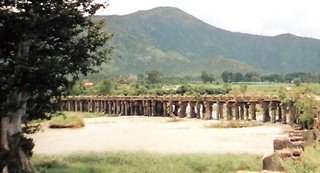Mysore city's Govt. Bus Terminal/07:15 hours
We arrived early to catch the one and only Mysore – Malvaddi - Kollegal Bus at 0745 hr which direct connects Shivasamudram on the way. The other option is a bus-change through Malvaddi town. The bus arrived Just-in-Time and we easily got seats. (Rs.32 per head.)
The bus took the straight road to Barnur and futher till Malavaddi. Hereafter, it took the Kollegal Road and reached Shivasamudram Power Plant (10:00). After momentarily entering this campus, it halted at the Hospital Bus stop and retracted back to Kollegal Road.
SHIVASAMUDRAM Village/10:10 hours
The village is reached after crossing over Kaveri river through a narrow bridge. 
However, all the beauty of the rapids and cascades of the river disappears when confronted by the auto- rickshaw thugs of the village. The falls being 11 kms from the village, these thugs have a monopoly of sorts. They demanded Rs.180 but haggling and a chance meeting with another two young men resulted in Rs. 160 for us four.
The falls are reached by crossing over a bridge which is adjacent to the 150 year-old arched Lushington stone bridge – motorable but not used.

Badachukki waterfall– spread over a 300 metres, it falls for 70 metres. The crest has a beautiful pond which can be reached by a flight of carved stairs. Down below, we witnessed several college teams in frolic and monkeys waiting for the opportune time. We immediately went in for boating in the local round boat (Rs.40). The experience to have the falls directly overhead gushing out the spray out on us was incredible. We returned back and headed for Gaganchukki waterfall.
Gaganchukki waterfall – this is a 90 m. long fall and bellows out huge clouds of water-sprays all around. Best viewed from behind the green-colored tomb of a savant . The descent is possible but not evident for the itinerant tourist so one must contend with the sight from a distance. The Muslim fraternity here, dishes out kababs. We returned back to village and then waited for the to Talakkad bus till 13:00 hrs, even as the buses to capital city of Bangalore kept a steady procession of sorts.
TALAKKAD/0530 hrs


The main temple is more or less intact. It is a large wall-enclosed square-complex 30 meters to one side, built of light brown stone, and is devoted to Lord Shiva. The temple-door’s two guards statue’s are identical but for the canines of one statue which differentiates them into mythological worlds of Devlok (World of Gods) and Asurlok (World of Demons) respectively – Lord Shiva being supreme over both sects. Their bellies also resemble the face of (holy bull and carrier of Lord Shiva) Nandi – a lithographic illusion. The imaginative sculptors even had Lord Ganesha sitting over a horse-faced mouse!!
We returned back to catch a bus to T.N.Narsipur town(20 kms, Rs.10) and from there, to Mysore (25 kms, Rs.12) where we reached back by 18:20 hrs. The six-bus trip cost us Rs.200( inclusive of food) per head.
No comments:
Post a Comment